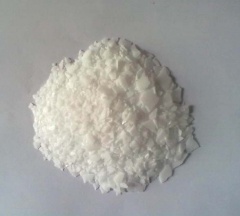Difference between revisions of "Naphtalene"
(→Application) |
m (→Shipment / Storage) |
||
| Line 17: | Line 17: | ||
Naphthalene is a petroleum product which gives off an unpleasant camphoric scent and may release inflammable gases. Above 80°C explosive vapor-air mixture (0.9-5.9%) may be formed. The product t is insoluble in water, soluble in ethyl [[ether]], ethanol, [[chloroform]], carbon disulfide and [[benzene]].<br><br> | Naphthalene is a petroleum product which gives off an unpleasant camphoric scent and may release inflammable gases. Above 80°C explosive vapor-air mixture (0.9-5.9%) may be formed. The product t is insoluble in water, soluble in ethyl [[ether]], ethanol, [[chloroform]], carbon disulfide and [[benzene]].<br><br> | ||
Produced as crystals, flakes, powder, or as liquid, the dust clouds from naphthalene may cause explosions. Stowage must be away from odour-sensitive goods, like coffee, foodstuffs and allied products. Good packaging is essential to container cargo vapor (if heated) which can attack the interior paintwork of containers. Hermetically sealed drums are considered to be the best option. | Produced as crystals, flakes, powder, or as liquid, the dust clouds from naphthalene may cause explosions. Stowage must be away from odour-sensitive goods, like coffee, foodstuffs and allied products. Good packaging is essential to container cargo vapor (if heated) which can attack the interior paintwork of containers. Hermetically sealed drums are considered to be the best option. | ||
| − | + | Contact with anything liable to sparks must be avoided.<br><br> | |
* Melting point; 80,2°C | * Melting point; 80,2°C | ||
* Boiling point; 218°C | * Boiling point; 218°C | ||
| Line 25: | Line 25: | ||
<i>Note:</i><br> | <i>Note:</i><br> | ||
For overseas carriage aspects of [[Chemicals]], the readers are recommended to acquire or have access to a good chemical dictionary, and a copy of the International Maritime Dangerous Goods (IMDG) Code, issued by the International Maritime Organisation. Also consult the applicable MSDS sheet.<br><br> | For overseas carriage aspects of [[Chemicals]], the readers are recommended to acquire or have access to a good chemical dictionary, and a copy of the International Maritime Dangerous Goods (IMDG) Code, issued by the International Maritime Organisation. Also consult the applicable MSDS sheet.<br><br> | ||
| + | |||
==Risk factors== | ==Risk factors== | ||
Naphthalene is toxic. In humans, being exposed to naphthalene can destroy red blood cells. Naphthalene may also cause cancer.<br><br> | Naphthalene is toxic. In humans, being exposed to naphthalene can destroy red blood cells. Naphthalene may also cause cancer.<br><br> | ||
Latest revision as of 14:34, 14 January 2021
| Infobox on Naphtalene | |
|---|---|
| Example of Naphtalene |  |
| Facts | |
| Origin | - |
| Stowage factor (in m3/t) |
|
| Humidity / moisture | |
| Ventilation | |
| Risk factors | |
Naphtalene
Description
Naphthalene (not to be confused with Naphtha) is a crystalline, white hydrocarbon, with a strong smell (detectable at concentrations as low as 0.08 ppm by mass). It is best known as the main ingredient in mothballs, and is also in urinal deodorizer blocks. Other names for naphthalene are naphthalin, naphthaline, tar camphor, white tar, albocarbon, or naphthene. It is used as an antiseptic. In mothballs, it is used as an insecticide or pesticide.
Application
Naphthalene is used mainly as a precursor to other chemicals. The single largest use of naphthalene is the industrial production of phthalic anhydride, although more phthalic anhydride is made from o-xylene. Other naphthalene-derived chemicals include alkyl naphthalene sulfonate surfactants, and the insecticide 1-naphthyl-N-methylcarbamate (carbaryl). Naphthalenes substituted with combinations of strongly electron-donating functional groups, such as alcohols and amines, and strongly electron-withdrawing groups, especially sulfonic acids, are intermediates in the preparation of many synthetic dyes. The hydrogenated naphthalenes tetrahydronaphthalene (tetralin) and decahydronaphthalene (decalin) are used as low-volatility solvents. Naphthalene is also used in the synthesis of 2-naphthol, a precursor for various dyestuffs, pigments, rubber processing chemicals and other miscellaneous chemicals and pharmaceuticals.
Naphthalene sulfonic acids are used in the manufacture of naphthalene sulfonate polymer plasticizers (dispersants), which are used to produce concrete and plasterboard (wallboard or drywall). They are also used as dispersants in synthetic and natural rubbers, and as tanning agents (syntans) in leather industries, agricultural formulations (dispersants for pesticides), dyes and as a dispersant in lead–acid battery plates.
Naphthalene sulfonate polymers are produced by reacting naphthalene with sulfuric acid and then polymerizing with formaldehyde, followed by neutralization with Sodium Hydroxide or calcium hydroxide. These products are commercially sold in solution (water) or dry powder form.
Shipment / Storage
Naphthalene is a petroleum product which gives off an unpleasant camphoric scent and may release inflammable gases. Above 80°C explosive vapor-air mixture (0.9-5.9%) may be formed. The product t is insoluble in water, soluble in ethyl ether, ethanol, chloroform, carbon disulfide and benzene.
Produced as crystals, flakes, powder, or as liquid, the dust clouds from naphthalene may cause explosions. Stowage must be away from odour-sensitive goods, like coffee, foodstuffs and allied products. Good packaging is essential to container cargo vapor (if heated) which can attack the interior paintwork of containers. Hermetically sealed drums are considered to be the best option.
Contact with anything liable to sparks must be avoided.
- Melting point; 80,2°C
- Boiling point; 218°C
- Flash point; 80°C
- Autoignitioin temp.; 526°C
Packaging in 25 kg plastic woven bag or fiber drum with the lining of plastic film.
Note:
For overseas carriage aspects of Chemicals, the readers are recommended to acquire or have access to a good chemical dictionary, and a copy of the International Maritime Dangerous Goods (IMDG) Code, issued by the International Maritime Organisation. Also consult the applicable MSDS sheet.
Risk factors
Naphthalene is toxic. In humans, being exposed to naphthalene can destroy red blood cells. Naphthalene may also cause cancer.
See also: http://www.chemicalland21.com/listaz01.htm#T











